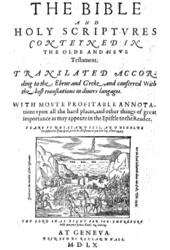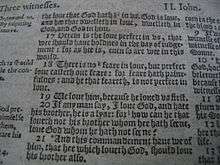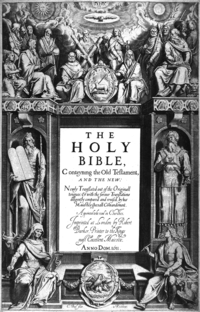Geneva Bible
| Geneva Bible | |
|---|---|
|
Geneva Bible 1560 edition | |
| Full name | Geneva Bible |
| Abbreviation | GEN |
| NT published | 1557 |
| Complete Bible published | 1560 |
| Textual basis | Textus Receptus |
| Religious affiliation | Protestant |
|
In the beginning God created the heaven and the earth. And the earth was without forme and voyde, and darkeness was upon the depe, and the Spirit of God moved upon the waters. Then God said, "Let there be light" and there was light. For God so loved the world, that he hath given his only be gotten Son, that whosoever beleveth in him, should not perish, but have everlasting life. | |
The Geneva Bible is one of the most historically significant translations of the Bible into English, preceding the King James Version by 51 years.[1] It was the primary Bible of 16th-century English Protestantism and was the Bible used by William Shakespeare,[2] Oliver Cromwell, John Knox, John Donne, and John Bunyan, author of Pilgrim's Progress (1678).[3] It was one of the Bibles taken to America on the Mayflower (Pilgrim Hall Museum and Dr. Jiang have collected several bibles of Mayflower passengers). The Geneva Bible was used by many English Dissenters, and it was still respected by Oliver Cromwell's soldiers at the time of the English Civil War, in the booklet "Cromwell's Soldiers' Pocket Bible".[4]
This version of the Bible is significant because, for the very first time, a mechanically printed, mass-produced Bible was made available directly to the general public which came with a variety of scriptural study guides and aids (collectively called an apparatus), which included verse citations that allow the reader to cross-reference one verse with numerous relevant verses in the rest of the Bible, introductions to each book of the Bible that acted to summarize all of the material that each book would cover, maps, tables, woodcut illustrations and indices.
Because the language of the Geneva Bible was more forceful and vigorous, most readers strongly preferred this version to the Great Bible. In the words of Cleland Boyd McAfee, "it drove the Great Bible off the field by sheer power of excellence".[5]
History
The Geneva Bible followed the Great Bible of 1539, the first authorized Bible in English, which was the authorized Bible of the Church of England.
During the reign of Queen Mary I of England (1553–58), a number of Protestant scholars fled from England to Geneva, Switzerland, which was then ruled as a republic in which John Calvin and, later, Theodore Beza, provided the primary spiritual and theological leadership. Among these scholars was William Whittingham, who supervised the translation now known as the Geneva Bible, in collaboration with Myles Coverdale, Christopher Goodman, Anthony Gilby, Thomas Sampson, and William Cole; several of this group later became prominent figures in the Vestments controversy. Whittingham was directly responsible for the New Testament, which was complete and published in 1557,[6] while Gilby oversaw the Old Testament.
The first full edition of this Bible, with a further revised New Testament, appeared in 1560,[6] but it was not printed in England until 1575 (New Testament[6]) and 1576 (complete Bible[6]). Over 150 editions were issued; the last probably in 1644.[6] The very first Bible printed in Scotland was a Geneva Bible, which was first issued in 1579.[6] In fact, the involvement of Knox and Calvin in the creation of the Geneva Bible made it especially appealing in Scotland, where a law was passed in 1579 requiring every household of sufficient means to buy a copy.[7]
Some editions from 1576 onwards[6] included Laurence Tomson's revisions of the New Testament. Some editions from 1599 onwards[6] used a new "Junius" version of the Book of Revelation, in which the notes were translated from a new Latin commentary by Franciscus Junius.
The annotations which are an important part of the Geneva Bible were Calvinist and Puritan in character, and as such they were disliked by the ruling pro-government Anglicans of the Church of England, as well as King James I, who commissioned the "Authorized Version", or King James Bible, in order to replace it. The Geneva Bible had also motivated the earlier production of the Bishops' Bible under Elizabeth I, for the same reason, and the later Rheims-Douai edition by the Catholic community. The Geneva Bible remained popular among Puritans and remained in widespread use until after the English Civil War. The Geneva notes were surprisingly included in a few editions of the King James version, even as late as 1715.[6]
| Part of a series on |
| Calvinism |
|---|
 |
|
Documents |
|
Peoples |
|
|
Translation
Like most English translations of the time, the Geneva Bible was translated from scholarly editions of the Greek New Testament and the Hebrew Scriptures that comprise the Old Testament. The English rendering was substantially based on the earlier translations by William Tyndale and Myles Coverdale (more than 80 percent of the language in the Genevan Bible is from Tyndale).[8] However, the Geneva Bible was the first English version in which all of the Old Testament was translated directly from the Hebrew (cf. Coverdale Bible, Matthew Bible).
Format
The Geneva Bible was the first English Bible to use verse numbers based on the work of Stephanus (Robert Estienne of Paris). It also had an elaborate system of commentary in marginal glosses. This annotation was done by Laurence Tomson, who translated (for the 1560 Geneva Bible) L'Oiseleur's notes on the Gospels, which themselves came from Camerarius. In 1576 Tomson added L'Oiseleur's notes for the Epistles, which came from Beza's Greek and Latin edition of the Bible (1565 and later). Beginning in 1599 Franciscus Junius' notes on Revelation were added, replacing the original notes deriving from John Bale and Heinrich Bullinger. Bale's The Image of both churches had a great effect on these notes as well as Foxe's Book of Martyrs. Both the Junius and Bullinger-Bale annotations are explicitly anti-Roman Catholic and representative of much popular Protestant apocalypticism during the Reformation.
The 1560 Geneva Bible was printed in Roman type—the style of type regularly used today—but many editions used the older black-letter ("Gothic") type. Of the various later English Bible translations, the next to use Roman type was the Douay-Rheims Bible of 1582 (New Testament) and 1609–10 (Old Testament).
The Geneva Bible was also issued in more convenient and affordable sizes than earlier versions. The 1560 Bible was in quarto format (218 × 139 mm type area), but pocketable octavo editions were also issued, and a few large folio editions. The New Testament was issued at various times in sizes from quarto down to 32º (the smallest, 70×39 mm type area[6]). In the late 16th century it is likely that the Geneva New Testament cost less than a week's wages even for the lowest-paid labourers.
The 1560 Geneva Bible contained a number of study aids, including woodcut illustrations, maps and explanatory 'tables', i.e. indexes of names and topics, in addition to the famous marginal notes. Each book was preceded by an 'argument' or introduction, and each chapter by a list of contents giving verse numbers. Smaller-format editions might be unillustrated and lack the marginal notes, but some large folio editions had additional illustrations, such as one showing Adam and Eve, where Adam wears a typical Elizabethan beard and moustache.
Breeches Bible

One interesting variation of the Geneva Bible is the so-called "Breeches Bible", the first of which appeared in 1579. In the Breeches Bible, Genesis Chapter III Verse 7 reads: "Then the eies of them both were opened, and they knew that they were naked, and they sewed figge tree leaves together, and made themselves breeches." In the King James Version of 1611, "breeches" was changed to "aprons". Geneva Bibles with the "breeches" passage continued to be printed well into the time of the King James Bible of 1611.

Modern spelling version of the 1599 Geneva Bible
In 2006, Tolle Lege Press released a version of the 1599 Geneva Bible with modernised spelling, as part of their 1599 Geneva Bible restoration project.[9] The original cross references were retained as well as the study notes by the Protestant Reformation leaders.[9] In addition, the Early Modern English glossary was included in the updated version.[9] The advisory board of the restoration project included several Protestant Christian leaders and scholars.[9] This can also be found on BibleGateway.com.[10]
Geneva Bible v. King James Version sample comparisons
To compare the Geneva Bible with the King James, here is Revelation 6:12–17 in both versions (with spelling modernized). The differences have been italicized (in both extracts):
|
Geneva Bible
|
King James Bible
|
Here are both the Geneva and the King James versions of Genesis 3:7 with spellings as in their originals (not modernized):
|
Geneva Bible
|
King James Bible
|

The two versions are very similar to each other. Examination of the differences shows that the earlier Geneva version is often more direct and modern in style than the later King James, e.g.
“and the moon was like blood” (Geneva) versus “and the moon became as blood” (King James)
“as a fig tree casteth her green figs” (Geneva) versus “even as a fig tree casteth her untimely figs” (King James)
By and large, the difference is that the KJV lacked footnotes that the Geneva Bible contained. The KJV does use the serial comma.
As can be seen by the text below, Daniel chapter 4 in the Geneva Bible appears to have removed two verses. In reality, the Geneva Bible places those two verses at the end of chapter 3, as the Hebrew, Greek, and Latin versions all did. It wasn't until the King James Version that those verses were placed with chapter 4 as opposed to chapter 3:
| Geneva Bible – Daniel 3 | King James Bible – Daniel 3 | ||
|---|---|---|---|
| 30 | Then the King promoted Shadrach, Meshach and Abednego in the province of Babel. | 30 | Then the king promoted Shadrach, Meshach, and Abednego, in the province of Babylon. |
| King James Bible – Daniel 4 | |||
| 31 | Nebuchad-nezzar King unto all people, nations and languages, that dwell in all the world, Peace be multiplied unto you: | 1 | Nebuchad-nezzar the king, unto all people, nations, and languages that dwell in all the earth, Peace be multiplied unto you. |
| 32 | I thought it good to declare the signes and wonders, that the hie God hath wrought toward me. | 2 | I thought it good to shew the signes, and wonders, that the high God hath wrought toward me. |
| 33 | How great are his signes, and how mightie are his wonders! his kingdome is an everlasting kingdome, and his dominion is from generation to generation. | 3 | How great are his signes? and how mighty are his wonders? his kingdome is an everlasting kingdome, and his dominion is from generation to generation. |
| Geneva Bible – Daniel 4 | |||
| 1 | I Nebuchad-nezzar being at rest in mine house, and flourishing in my palace, | 4 | I Nebuchadnezzar was at rest in mine house, and flourishing in my palace. |
| 2 | Saw a dreame, which made me afraide, and the thoughtes upon my bed, and the visions of mine head troubled me. | 5 | I saw a dreame which made me afraid, and the thoughts upon my bed, and the visions of my head troubled me. |
| 3 | Therefore, made I a decree, that they should bring all the wise men of Babel before mee, that they might declare unto me the interpretation of the dreame. | 6 | Therefore, made I a decree, to bring in all the wise men of Babylon before mee, that they might make knowen unto me the interpretation of the dreame. |
King James I and the Geneva Bible

In 1604, the year after claiming the throne of England in 1603, King James I hosted and presided over a conference pertaining to matters religious, the Hampton Court Conference. While the Geneva Bible was the preferred Bible of Anglican and Puritan Protestants during the Elizabethan Age, King James I disliked the Geneva Bible and made his views clearly known at the conference: "I think that of all [English Bibles], that of Geneva is the worst." Apparently, his distaste for the Geneva Bible was not necessarily upon all the translations of the numerous passages into English, but mostly the annotations in the margins. He felt strongly many of the annotations were "very partial, untrue, seditious, and savoring too much of dangerous and traitorous conceits..." In all likelihood, he saw the Geneva's interpretations of biblical passages as anti-clerical "republicanism", which could imply church hierarchy was unnecessary. Hypothetically, it followed that the need for a king as head of church and state could be questioned also. He had been dealing with similar issues with his Presbyterian-Calvinist religious leaders back in Scotland, and he wanted none of the same controversies in England. Also, if annotations were in print, readers might believe these interpretations correct and fixed, making it more difficult to change his subjects' minds about the meanings of particular passages.

So when two Puritans towards the end of the conference suggested that a new translation of the Bible be produced to unify better the Anglican Church in England and Scotland, James embraced the idea. He could not only be rid of those inconvenient annotations, but he could have greater influence on the translation of the Bible as a whole. He commissioned and chartered a new translation of the Bible which would eventually become the most famous version of the Bible in the history of the English Language. Originally known as the Authorized Version to be read in churches, the new Bible would forever bear his name as the so-called King James Bible. The first and early editions of the King James Bible from 1611 and the first few decades thereafter lack annotations, unlike nearly all editions of the Geneva Bible up until that time.[11] Initially, the King James Version did not sell well and competed with the Geneva Bible. Shortly after the first edition of the KJV, King James banned the printing of new editions of the Geneva Bible to further entrench his version. However, Robert Barker continued to print Geneva Bibles even after the ban, placing the erroneous date 1599 on new copies of Genevas which were actually printed circa 1616 to 1625.[12] Despite popular misconception, the Bible initially brought to North America by the Puritan Separatists or Pilgrim Fathers aboard the Mayflower in 1620 was the Geneva Bible not the King James Version.
See also
References
- ↑ Metzger, Bruce (1 October 1960). "The Geneva Bible of 1560". Theology Today. 17 (3): 339. doi:10.1177/004057366001700308.
- ↑ Ackroyd, Peter (2006). Shakespeare: The Biography (First Anchor Books ed.). Anchor Books. p. 54. ISBN 978-1400075980.
- ↑ 1599 Geneva Bible.
- ↑ Metzger, Bruce (1 October 1960). "The Geneva Bible of 1560". Theology Today. 17 (3): 351. doi:10.1177/004057366001700308.
- ↑ McAfee, Cleland Boyd, Study of the King James Bible, Project Gutenberg.
- 1 2 3 4 5 6 7 8 9 10 Herbert, AS (1968), Historical Catalogue of Printed Editions of the English Bible 1525–1961, London, New York: British and Foreign Bible Society, American Bible Society, SBN 564-00130-9.
- ↑ A Chronology of the English Bible, Bible researcher.
- ↑ Daniell, David (2003) The Bible in English: history and influence. New Haven and London: Yale University Press ISBN 0-300-09930-4, p. 448 and see the Wikipedia article for David Daniell
- 1 2 3 4 "Restoration project", 1599 Geneva Bible.
- ↑ https://www.biblegateway.com/versions/1599-Geneva-Bible-GNV/
- ↑ http://founders.org/fj86/the-geneva-bible-and-its-influence-on-the-king-james-bible/#N_32_
- ↑ Nicolson, Adam. God's Secretaries: The Making of the King James Bible (HarperCollins, 2003)
External links
Text
- Geneva Bible Footnotes
- Geneva Bible online (1599)
- Modern Spelling Geneva Bible with Footnotes for the Gospels
- Downloadable cleartext of Geneva Bible (from scripture.sourceforge.net)
- Works by or about Geneva Bible at Internet Archive
Articles
- The Geneva Bible of 1560: article by Bruce Metzger originally printed in Theology Today
- Online version of Sir Frederic G. Kenyon’s article in Hastings' Dictionary of the Bible, 1909
- Geneva Bible-History From Cambridge Encyclopedia
Editions Currently in Print
- 1560 First Edition: Facsimile Reproduction
- 1560 First Edition Reduced size Facsimile Reproduction by Hendrickson
- 1599 Edition: Modern Spelling and Typesetting from The 1599 Geneva Bible Restoration Project (no illustrations)
| Library resources about Geneva Bible |
